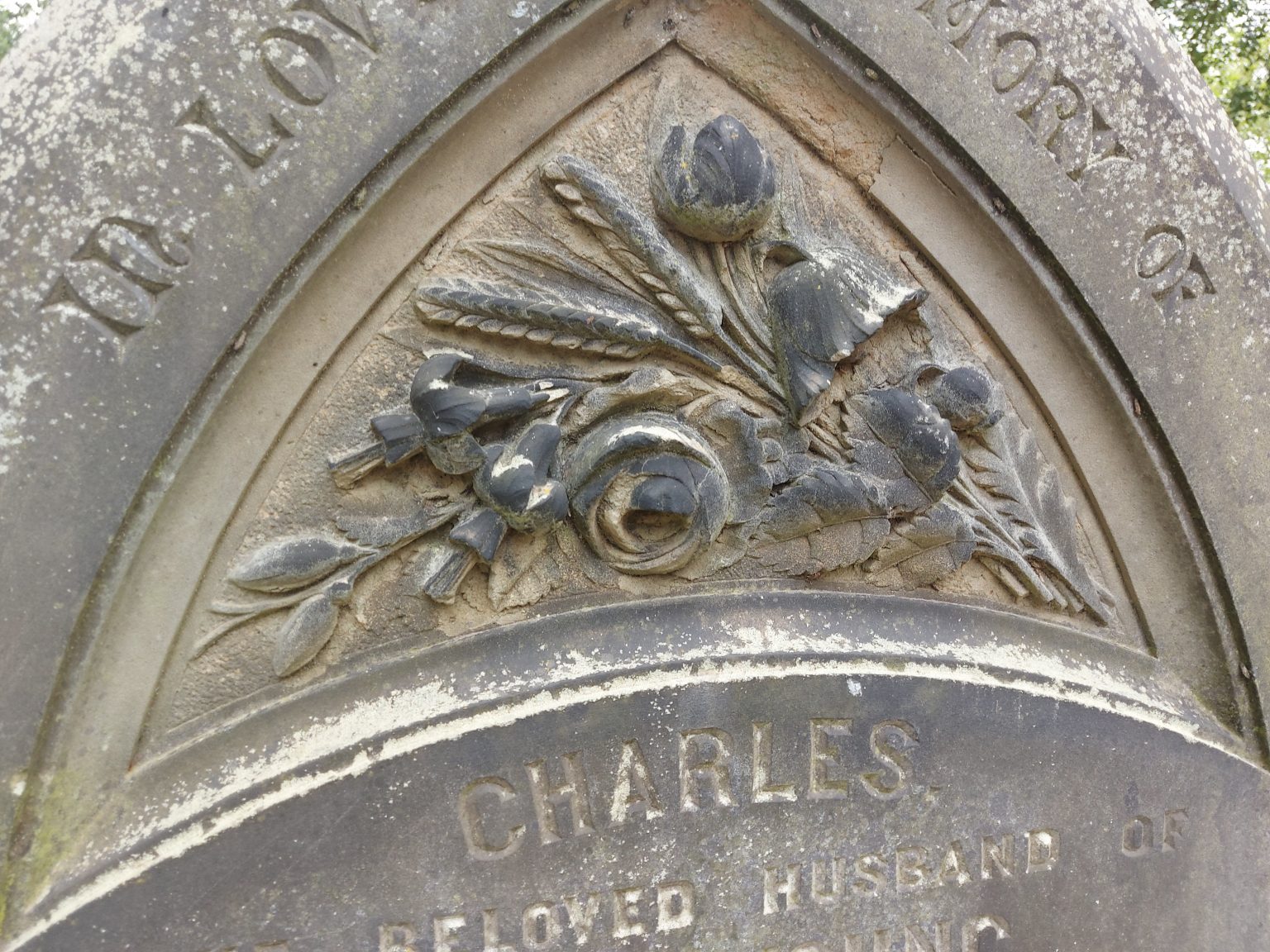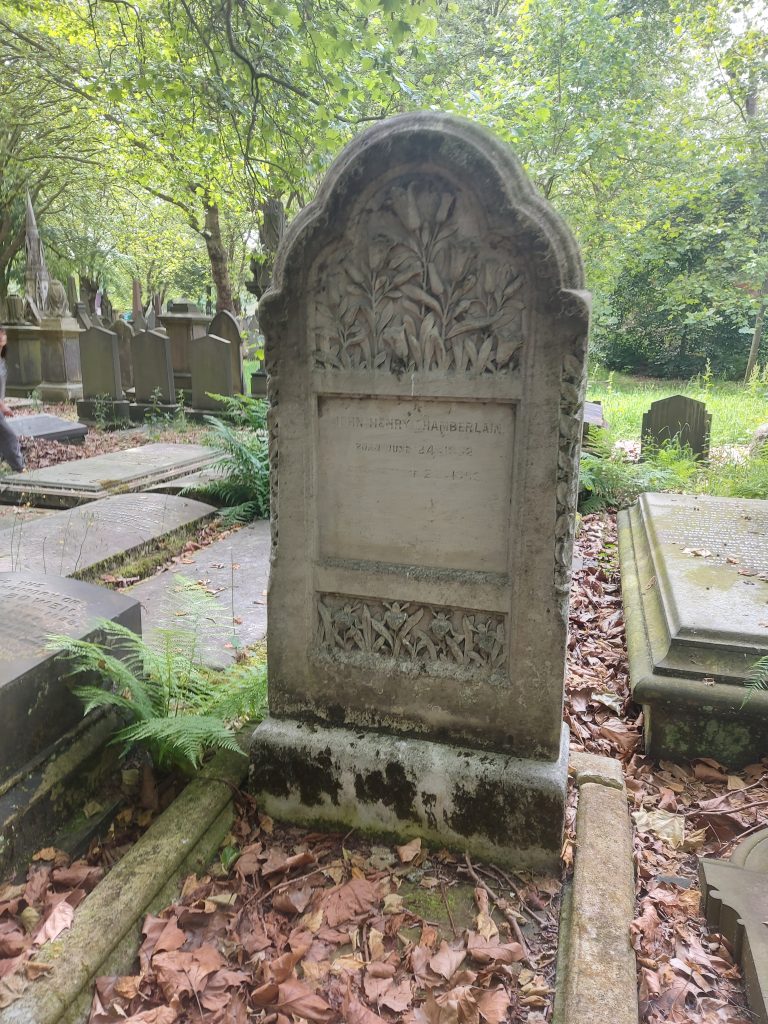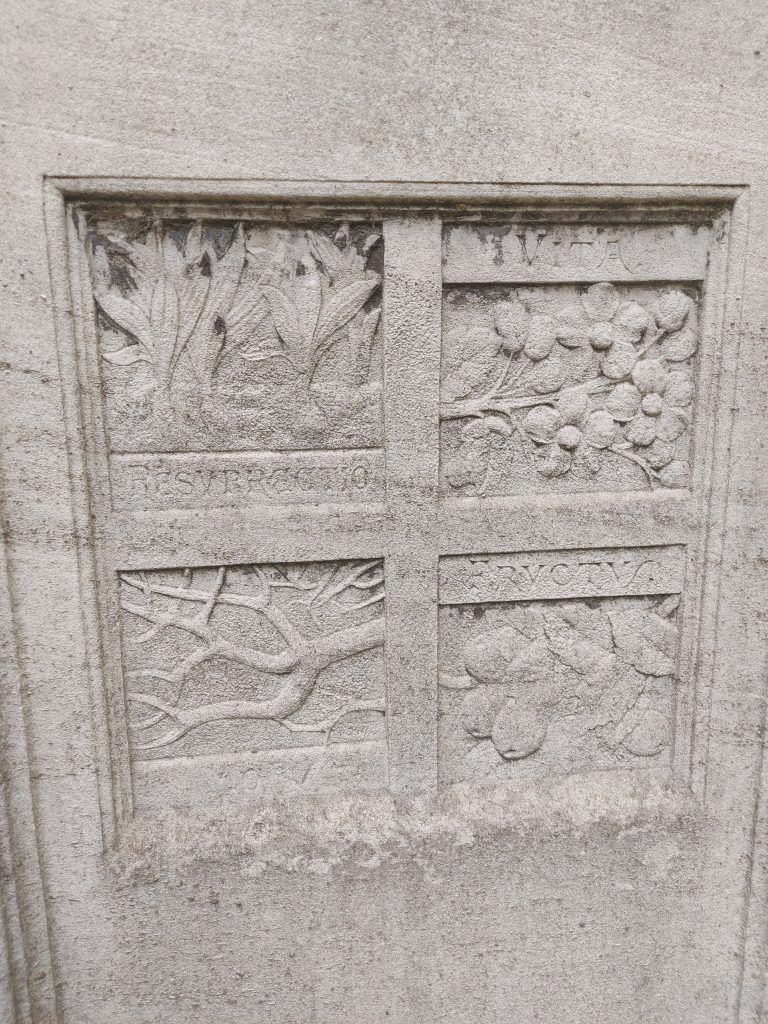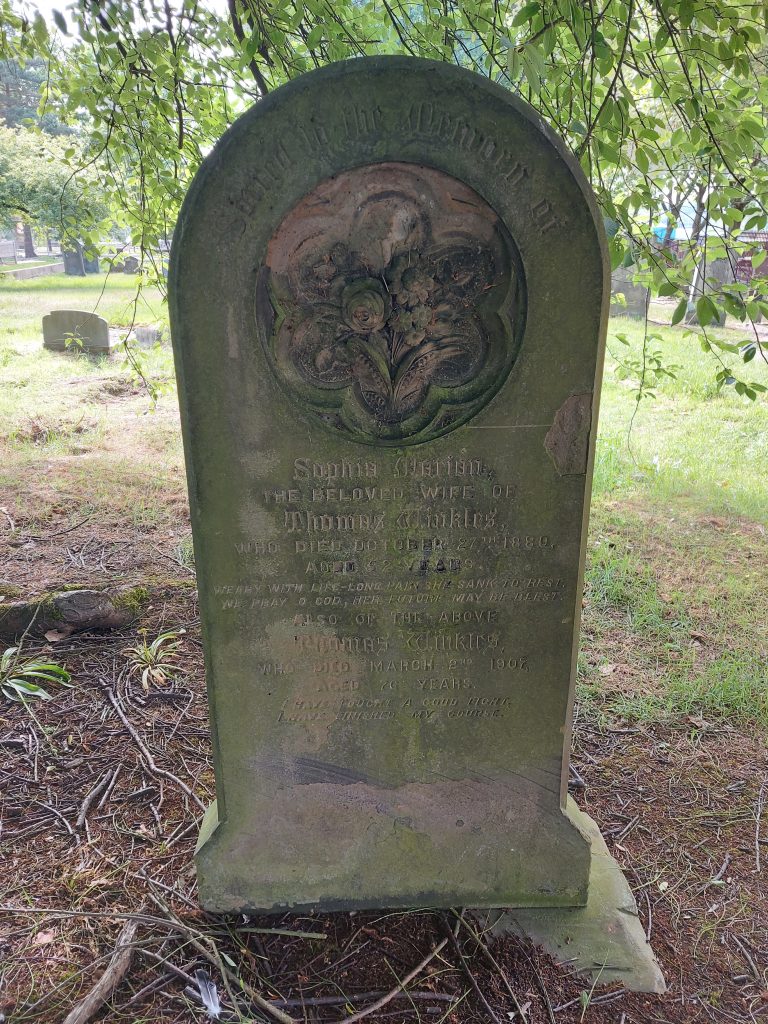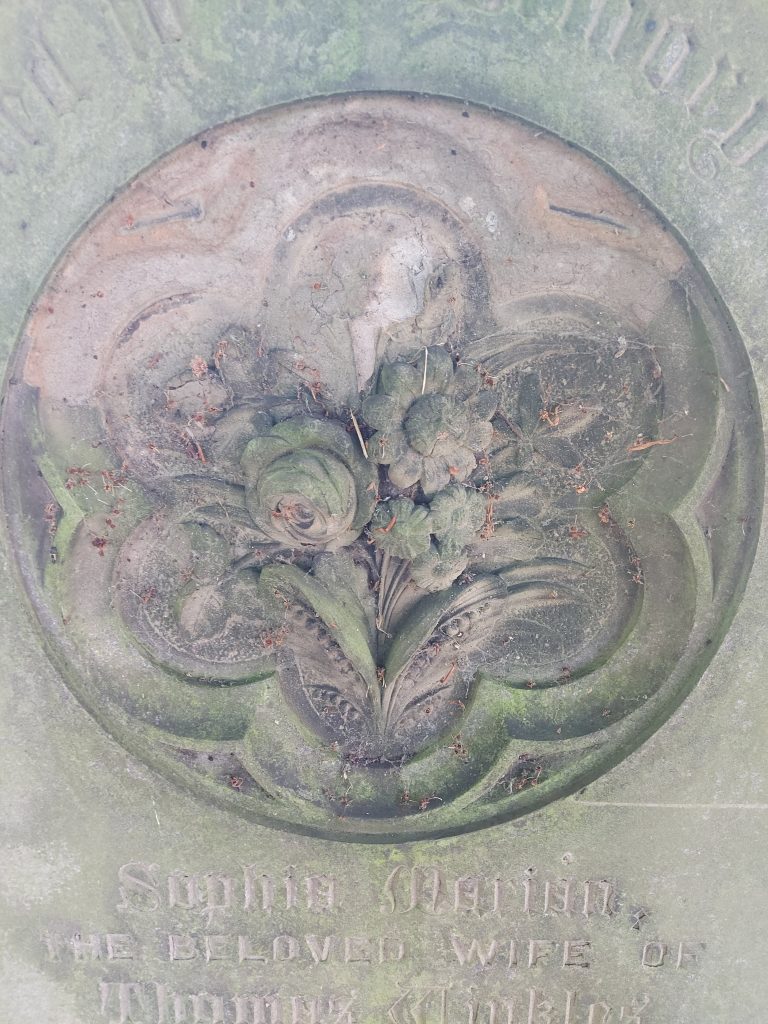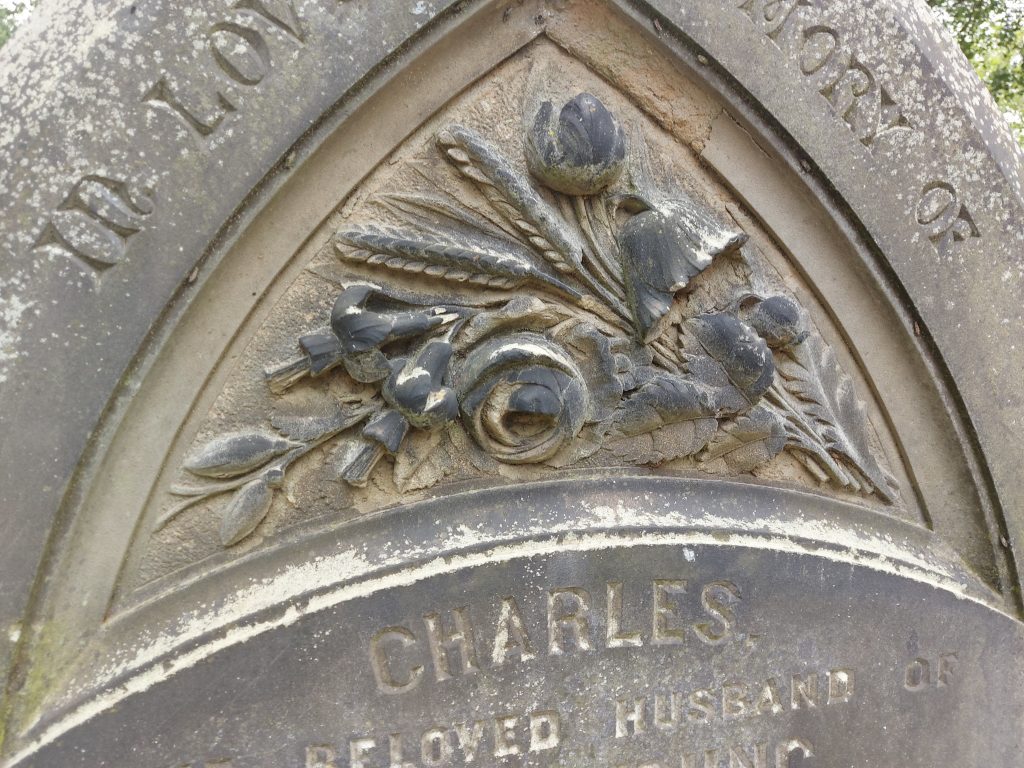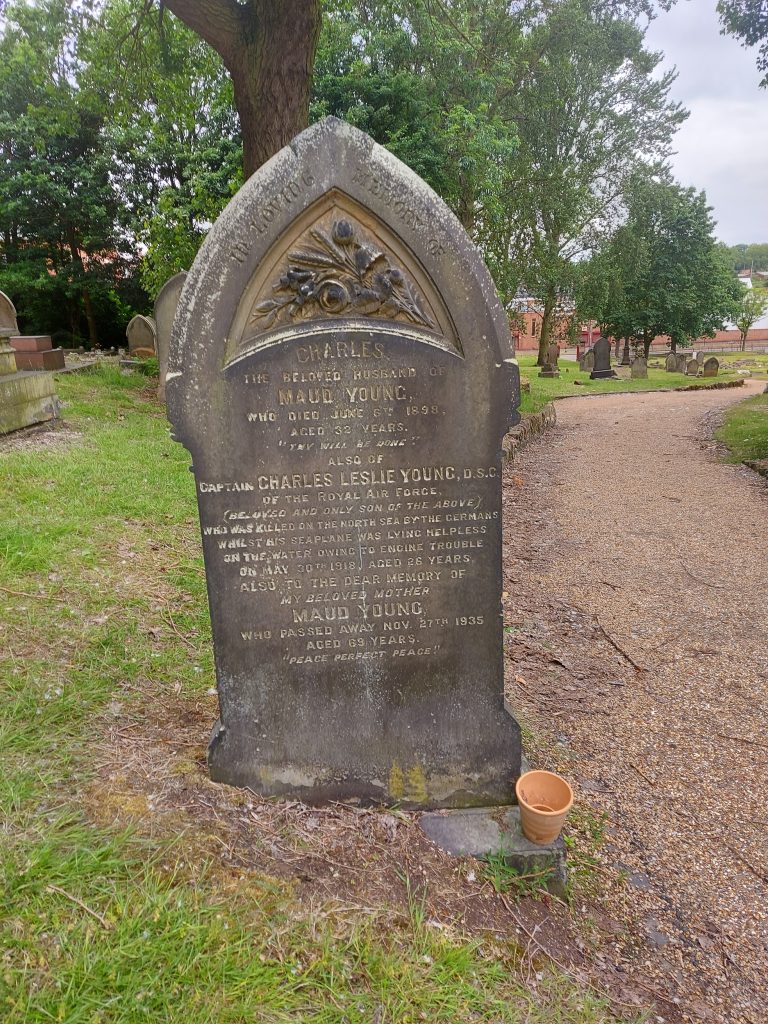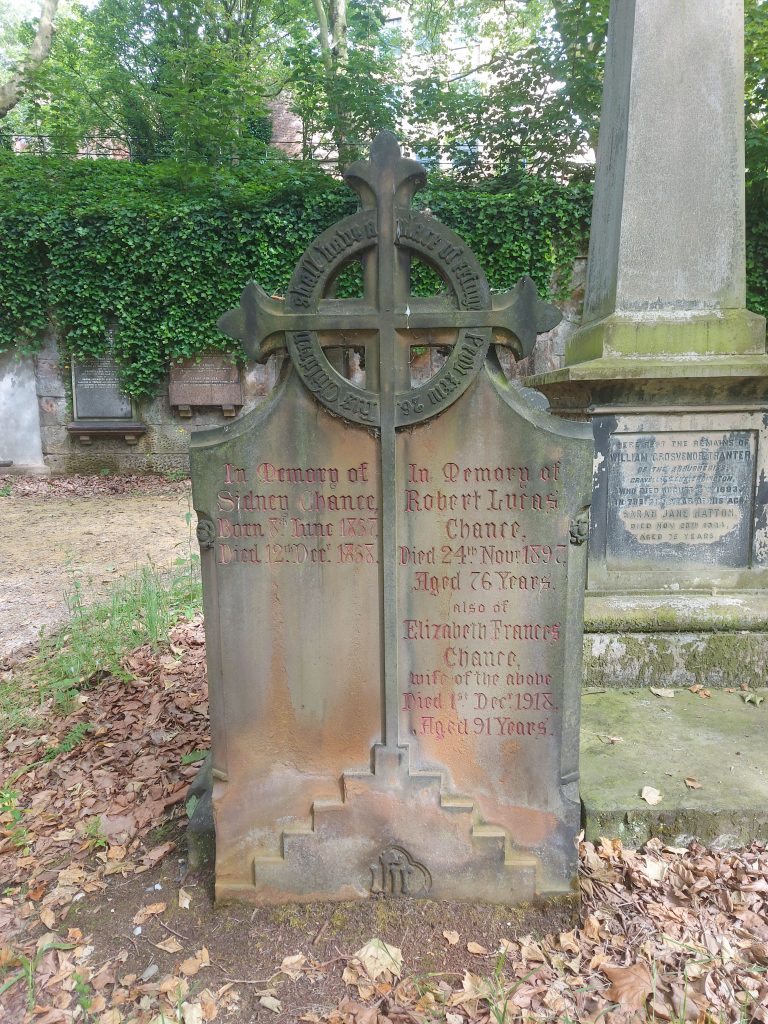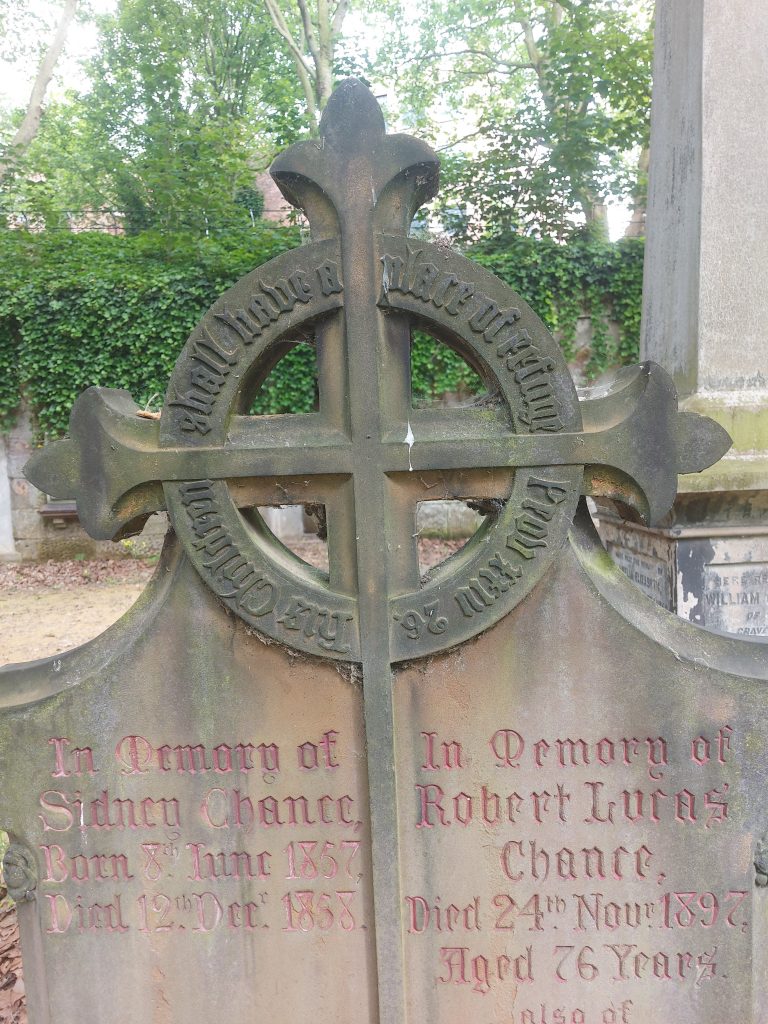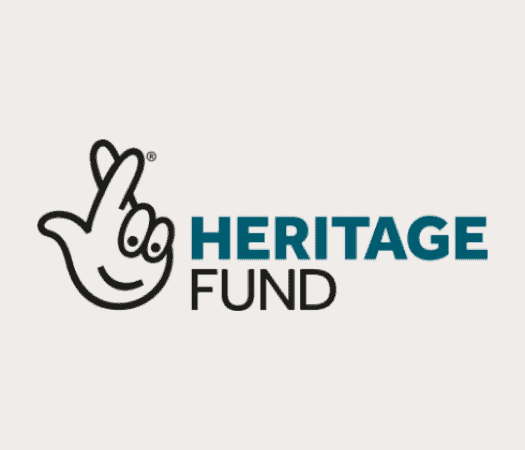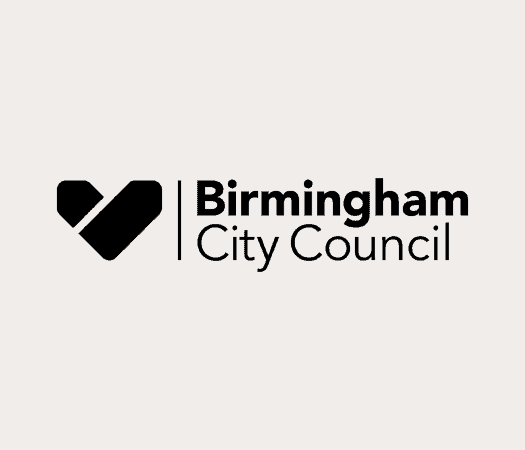Cemeteries are full of art and meaning. Every carved stone and gravestone form can be read like a book, and although many of these meanings are obscure to us now, they would have been readily apparent to Victorian visitors. If you take a stroll through the cemeteries, or visit online using the virtual tours, you may spot many of these symbols. Some are common and appear often, others are unique pieces of sculpture.
Natural forms
Nature is all around us in the cemeteries, both with the trees and plants that grow there and provide homes for wildlife, but also in the shapes and symbolism of many of the monuments.
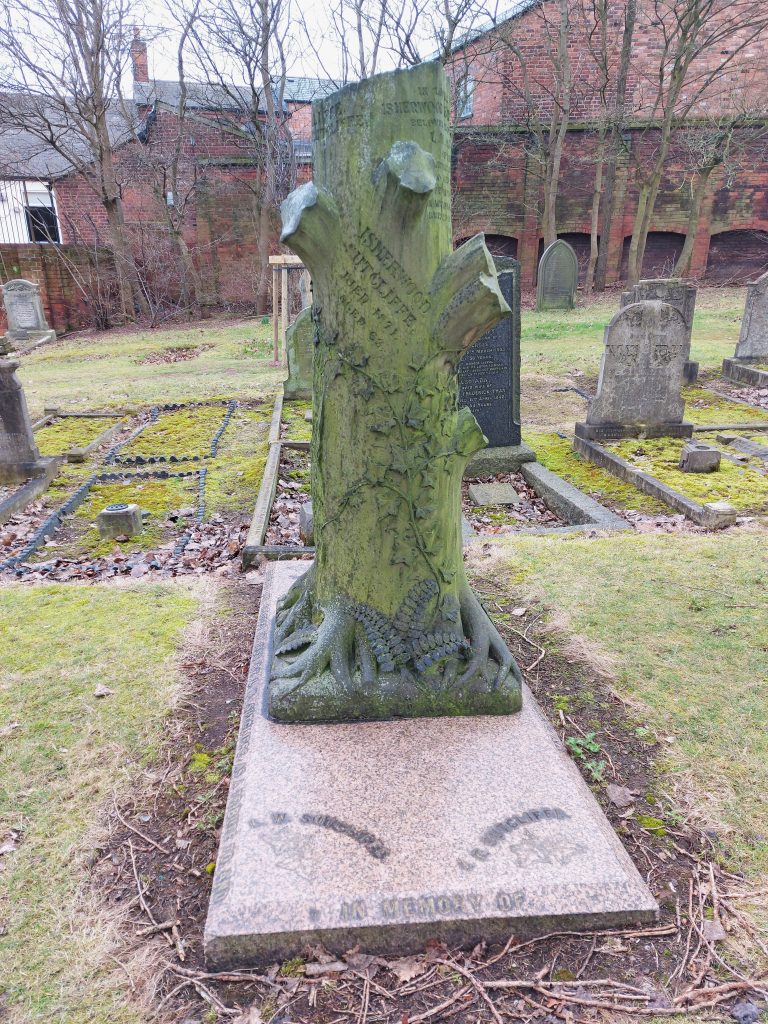
Sutcliffe Family
Warstone Lane Cemetery, Section D, Plot 1366
One of the most beautiful and unusual monuments in Warstone Lane Cemetery was designed and erected by Lichfield Watton Sutcliffe in 1888 in memory of his father, mother and kindred. Lichfield Watton was later buried there along with his wife Ada Jane. Their son Isherwood Edmond Sutcliffe who died fighting in France with the Royal Warwickshire Regiment in 1916 is also commemorated although he is buried in Rouen. This memorial was inspired by the arts and crafts movement which was very popular with Birmingham designers in this era. William Morris is the most famous figure from this movement, his work and other arts and crafts pioneers were inspired by natural forms and traditional craft techniques, which they hoped to preserve.
Tree Stump
Memorials designed to look like tree stumps were popular in the later part of the 19th century and like broken columns they symbolise a life cut short.
Ivy
Ivy has lots of meanings. Because it is evergreen it is associated with immortality and fidelity. Because it clings and entwines it is a symbol of friendship. The three pointed leaves can represent the trinity.
Ferns
Fern collecting was a popular hobby for }Victorians. Ferns can symbolise humility and sincerity.
John Henry Chamberlain
Key Hill Cemetery, Section K, Plot 701
John Henry Chamberlain (no relation of Joseph Chamberlain) was an architect who made a significant contribution to Birmingham. He was known for designing in the Gothic style, with many arts and crafts elements, inspired by the teachings of John Ruskin.
J H Chamberlain designed many of Birmingham’s Civic buildings including 41 board schools, one of which is now finding new life as the Ikon Gallery in Brindley Place. He also designed libraries, hospitals and public utilities. His work is characterised by a gothic medieval-English inspired style, decorative ironwork, and terracotta details, and often included detailed naturalistic elements. He also designed Highbury Hall and the Birmingham School of Art, but this was not completed until after his death by his business partner William Martin. His gravestone is a work of art in it’s own right, featuring a relief of lilies on the front and a depiction of the lifecycle of an apple tree on the reverse, along with latin inscriptions meaning resurrection, life, fruit and death. It is believed to have been designed by J H Chamberlain himself.
Apples: a symbol of knowledge and earthly sins because of their association with the Garden of Eden.
Headstones with a floral relief were very popular in the Midlands during the 19th century, so there are many examples in the Jewellery Quarter cemeteries. For the Victorians, each flower had it’s own meaning, so these panels really pack a symbolic punch as well as being beautiful bouquets. Many flowers have multiple associations, so different readings of the same gravestone are possible. What do you think these families were trying to say?
Winkles Family
Warstone Lane Cemetery, Section E, plot 57
Passionflower: the shape looks like the ‘crown of thorns’ and so this is a symbol of Christ’s passion and crucifixion.
Lily of the Valley: associated with innocence and purity because of the delicate white flowers
Daisies: associated with children and baby Jesus, innocence and the Virgin Mary.

John Postgate
Warstone Lane Cemetery, Section E plot 7
John Postgate was born in Scarborough in 1820. Aged 11 he was as an apprentice grocer and saw goods adulterated with cheaper ingredients, a common but dangerous practice. John became a doctor, starting as a Birmingham GP in 1851. He cam-paigned against food adulteration, but this time consuming work was unpaid, so his family life suffered. Mary Ann Postgate was well-educated with dreams of being a writer, but instead struggled to raise their seven children on a limited budget. Effec-tive food adulteration legislation was finally passed in the 1870s. Postgate died from stomach cancer in 1881 and his grave-stone commemorates his campaign.
The flowers here include roses, ferns and primroses.
Primroses: Associated with love, memory, youth, hope and sadness.
Captain Charles Leslie Young
Warstone Lane Cemetery, Section L, plot 1154
A tragic tale from WWI is relayed in the inscription on this headstone which remembers the son of Charles and Maud Young: ‘Who was killed on the North Sea by the Germans whilst his seaplane was lying helpless on the water owing to engine trouble’‘. The stone was originally erected in 1898 in memory of Charles Senior, so the use of poppies here is unrelated but all the more poignant.
Poppies: Traditionally associated with sleep and dreams. The red colour can also represent Christ’s blood. Became a symbol of Remembrance after WWI.
Fuchsia: This plant can symbolise humble or confiding love.
Music
The most commonly depicted musical instrument on gravestone is the lyre, because this Ancient Greek instrument fits well with Neoclassical style memorials and has a long association with the musical and poetic arts. Sometimes it is depicted with a broken string to represent life cut short. Depictions of other instruments are much rarer and are usually have a personal association with the person commemorated.
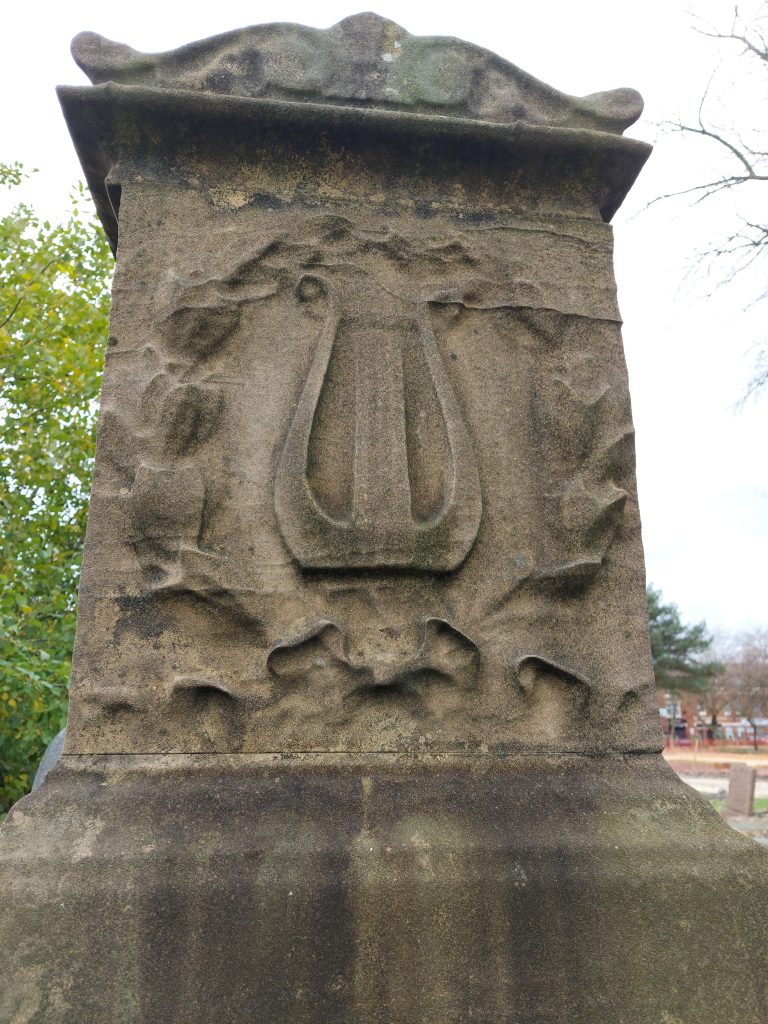
Joseph Moore
Warstone Lane Cemetery Section D, plot 926
Joseph Moore was a wealthy manufacturer of buttons and other metal goods. He was a lover of music and became the organiser of the Birmingham Triennial Festival – concerts which raised money for the Birmingham General Hospital. The Town Hall was built as a venue for the festivals, and its organ technically belonged to the hospital. Moore wrote to the composer Mendelssohn, asking him to come to Birmingham to play. In 1846, the first performance of Elijah, was at the Birmingham Festival.
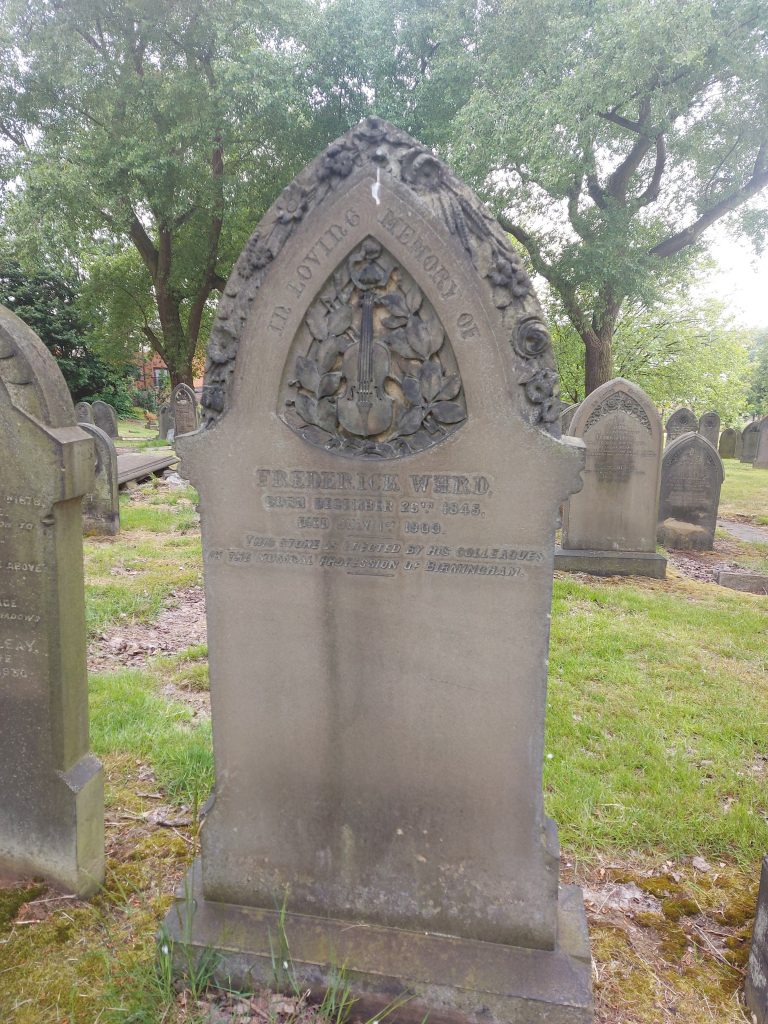
Frederick Ward
Warstone Lane Cemetery, Section K, Plot 216
This unusual headstone features a violin and was erected in memory of Frederick Ward who died in 1900, by ‘his colleagues in the musical profession of Birmingham’.
A concert programme from 1896 for a concert in the City Assembly Rooms on Hurst Street included ‘Fred Ward’s Quartet’ in the line up and the 1871 census describes him as a ‘Professor of Music.
Laurel wreath: Presented to victors and champions in Greece and Rome including Olympic athletes and military commanders, these wreaths symbolise victory and honour.
The cemeteries have their own music, created by the Blackbirds, Wrens, Song Thrushes, Blue Tits, Robins and a whole host of other feathered singers, from the raucous caws of the crows to the soft cooing of the Wood Pigeons.
Redpath Family
Warstone Lane Cemetery, Section K, plot 117
George and his wife Mary were born in Scotland but by 1871 were living in Bir-mingham.
George was a ‘licensed vict-ualler’ or ‘wine and spirit merchant’. Together they ran the Red Cow in Dale End and then the Rose and Punch Bowl in Bull Street.
Dove: a symbol of purity and peace. Sometimes carrying the olive branch like the Dove that flew back to Noah’s Ark.
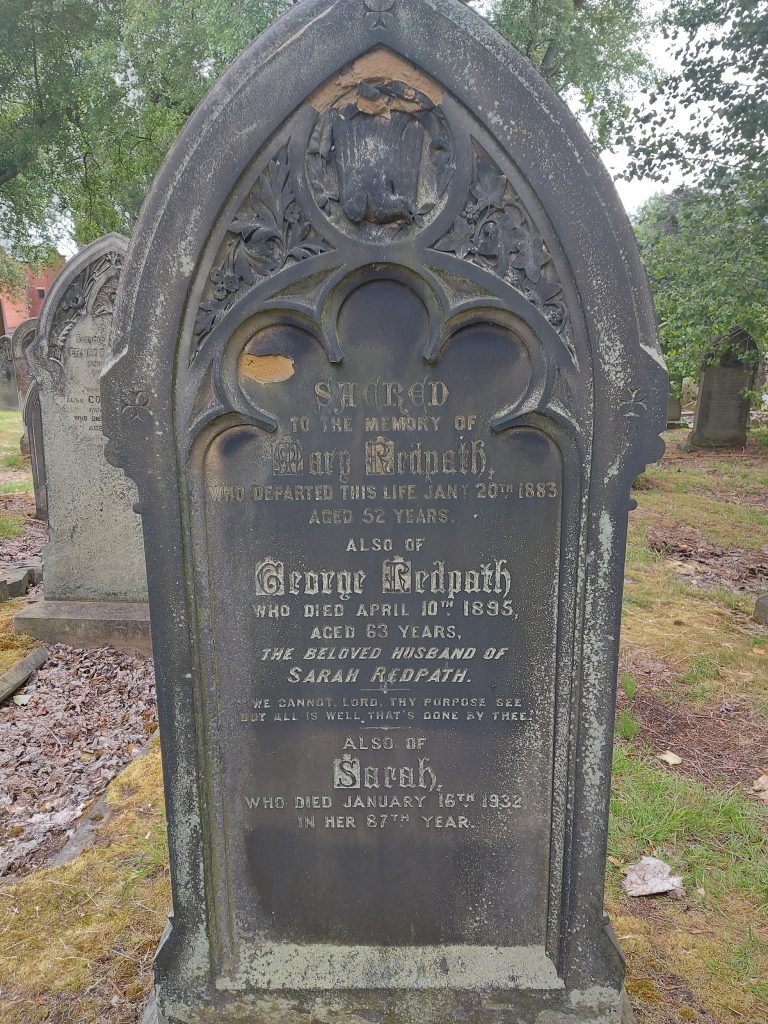
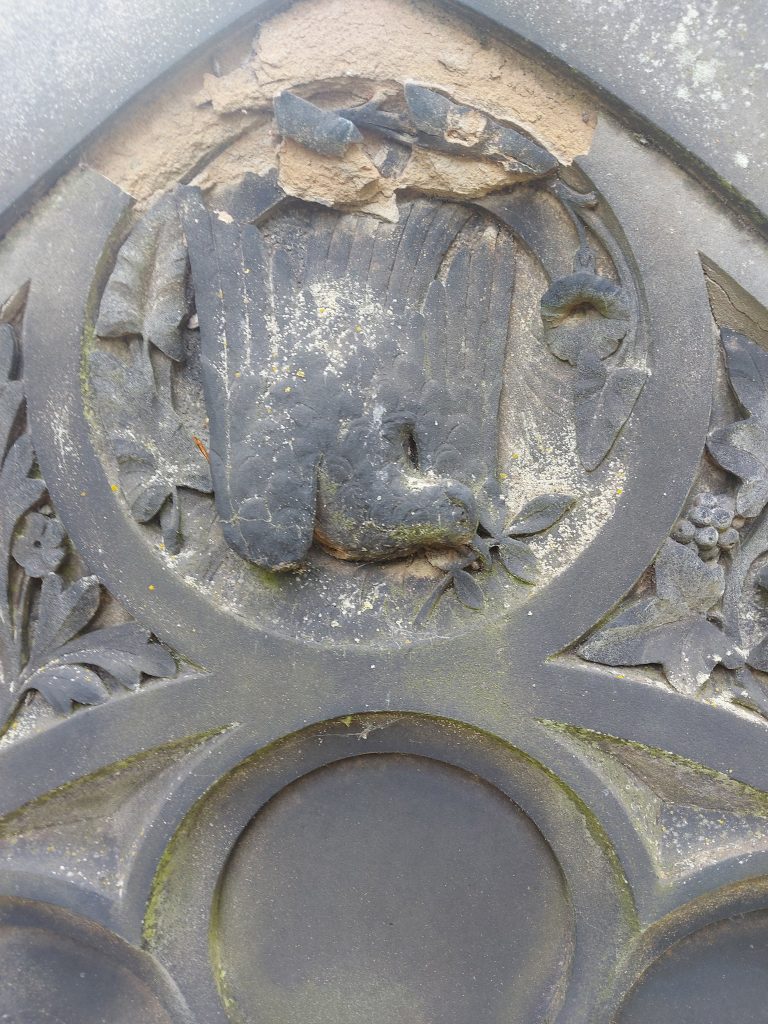
Crosses and Christian symbols
Key Hill Cemetery was originally known as the Birmingham General Cemetery and was open to people of all creeds and denominations, although fewer Anglicans were buried there because the Church of England Cemetery (now known as Warstone Lane Cemetery) opened next door only 12 years later. In reality there are people of all faiths and none buried in both cemeteries, but the majority were Christians (of one denomination or another) and so many graves feature crosses and other Christian symbols.
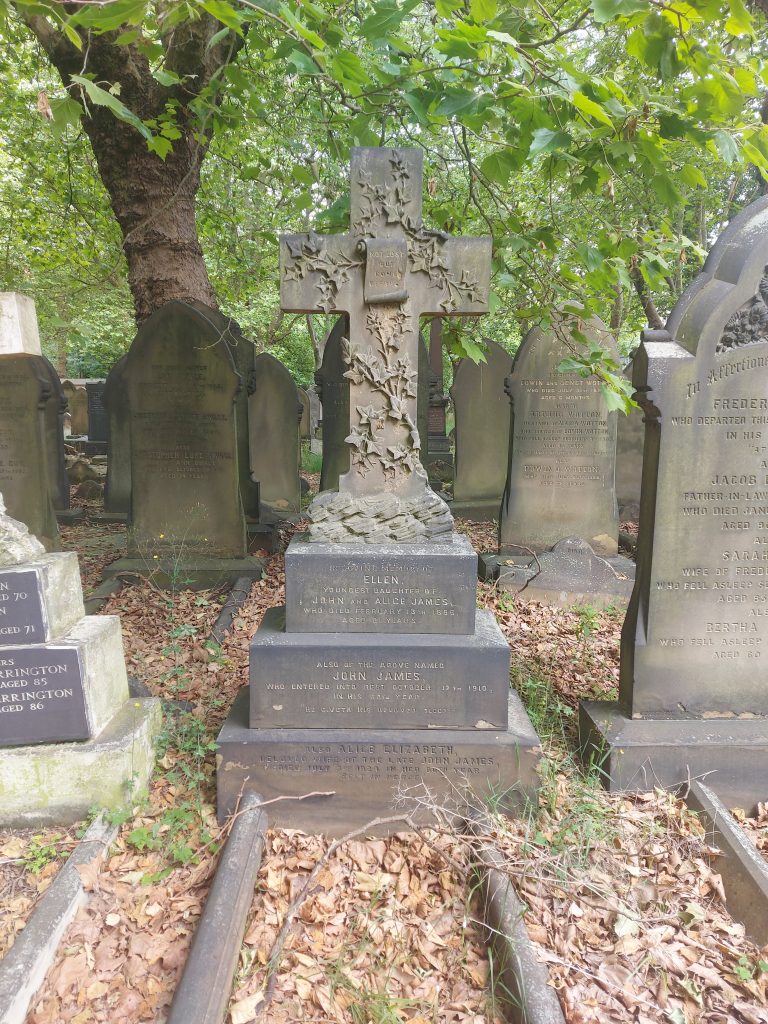
James Family
Key Hill, Section Q, Plot 784
“Not lost but gone before”
John James was an Electroplater and Gilder, he and his wife Alice Elizabeth were both born in Birmingham, but the census shows that their 2 children were born in Germany but were British citizens, so they must have spent some time in Germany before returning to the city. Their daughter Ellen, was a Stationers assistant but sadly died young, aged only 21.
Cross with 3 step base: crosses often have a 3 tier base to represent the holy trinity.
This ornate example is also entwined with ivy.
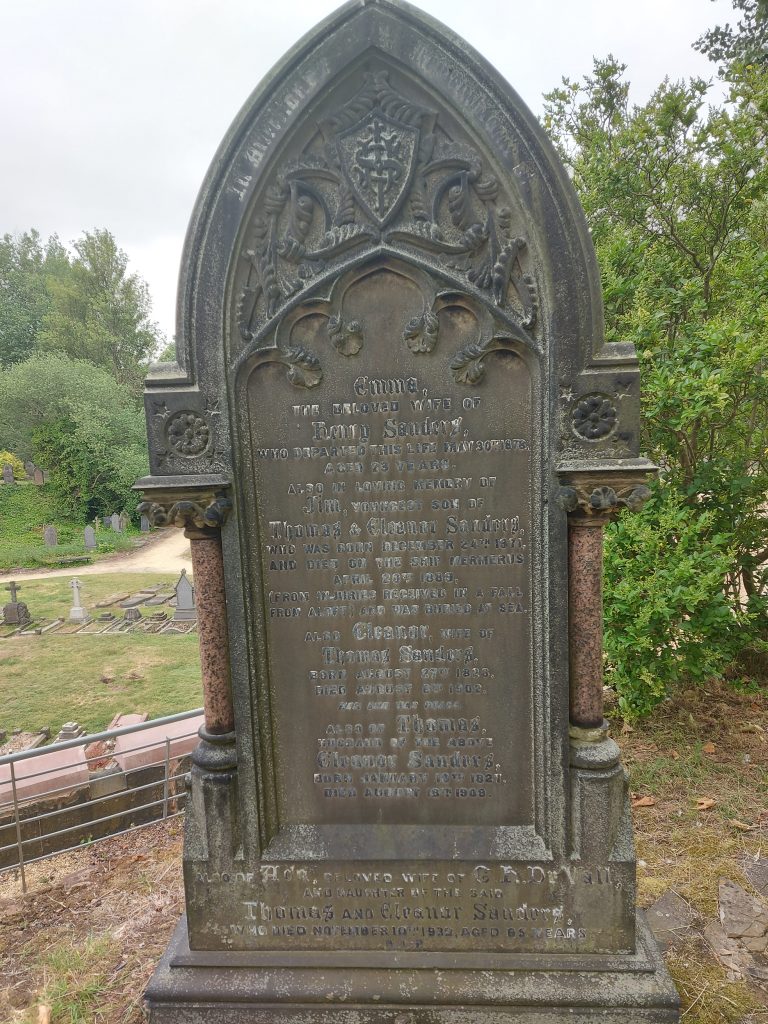
Sanders family
Warstone Lane Cemetery, Section I, plot 1945
The Sanders family grave includes a memorial to Jim Sanders, the youngest son of Thomas and Eleanor who ‘died on the ship Mermerus April 20th 1889, (from injuries received in a fall from aloft) and was buried at sea.’ The ship was an iron sailing ship built in Glasgow for the Australian Wool trade.
This highly decorated gravestone has a shield containing another Christian symbol – IHS
IHS: These letters are the first three letters of Jesus in the Greek Alphabet. They are often intertwined. Not commonly used on Anglican graves before the 19th century as considered too Catholic.
As well as the Gothic revival in the 19th century, which influenced the shapes and styles of many gravestones, there was also a Celtic revival in art and architecture, not just in Ireland and Scotland, but also around the world. Celtic or ringed crosses feature heavily in many British cemeteries, including the Jewellery Quarter.
Chance Family
Key Hill Cemetery, Section L, plot 12
Robert Lucas Chance (and his brother William who is buried in the catacombs at Warstone Lane Cemetery) were the owners of Chance Brothers and Company, glass manufacturers which operated from a factory on Spon Lane in Smethwick and were once the largest British manufacturer of window glass, plate glass, and optical glass for lighthouses, telescopes and cameras. Chance glass are best known for glazing Crystal Palace for the Great Exhibition in 1851.
‘his children shall have a place of refuge’
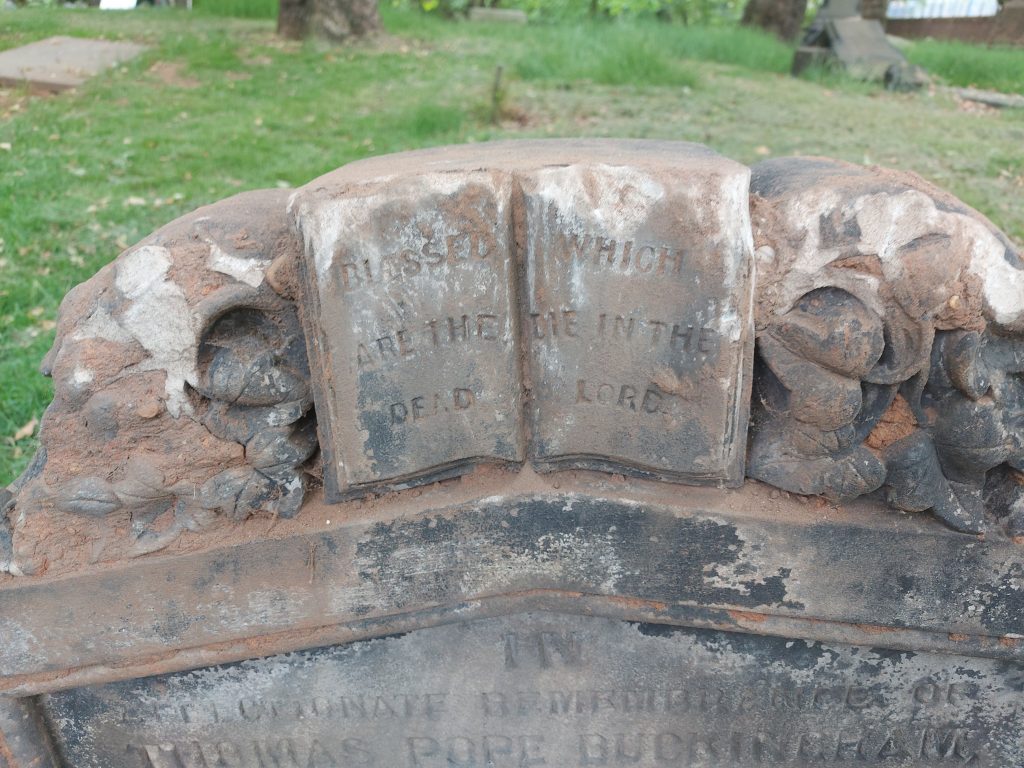
Thomas Pope Buckingham
Key Hill Cemetery, Section P, plot 318
Was a minister of the Gospel for more than 50 years and one of the chaplains of Key Hill Cemetery.
‘Blessed are the dead which die in the Lord’
Book: usually represents the bible unless the deceased was a writer. A closed book means ‘life completed’, an open book is ‘open to god’.
Heavenly figures
Like many cemeteries of a similar age, many of the statues in Key Hill and Warstone Lane have lost arms, heads and other features over the years, but not their beauty. The most common motifs for statues in cemeteries are weeping figures of mourning, representations of hope with an anchor or faith with a cross, along with flights of angels and cherubs.
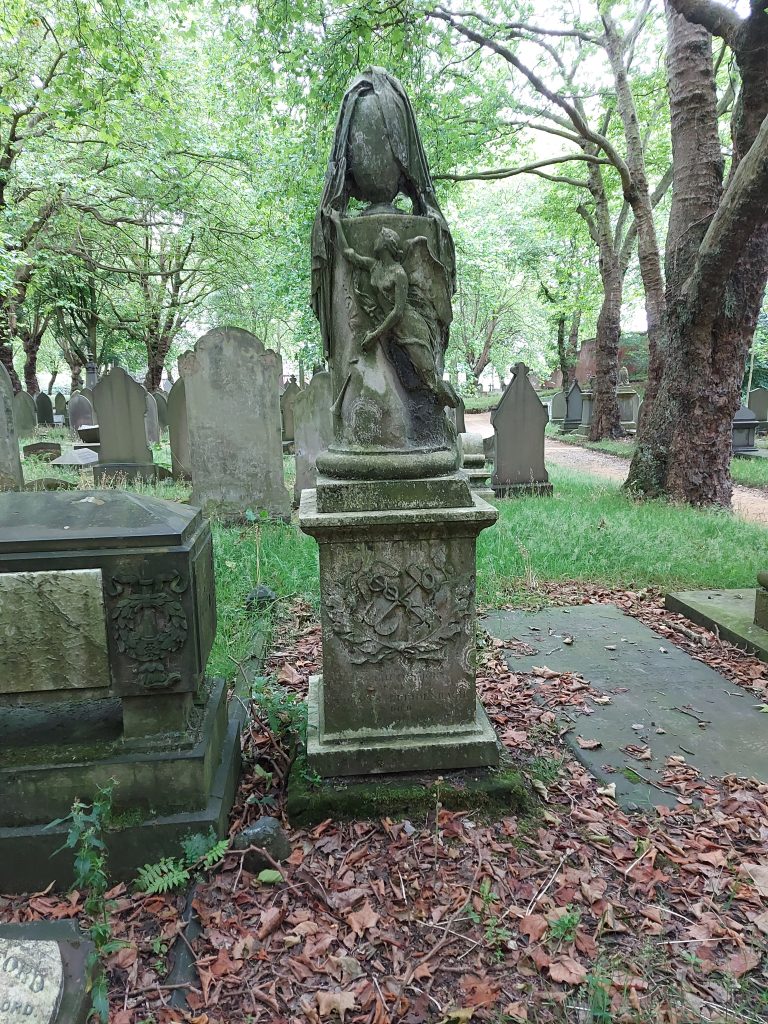
Thomas Briedenbach
Key Hill Cemetery, Section K, plot 944
This memorial of unusually fine quality was carved from marble by Fedi of Florence and commemorates Thomas Breidenbach who was a merchant—perhaps explaining the inclusion of the anchor and caduceus (which can symbolise commerce and negotiation) on his grave.
Angel with Trumpet
Seen as a herald of the resurrection, represents the day of judgement and entry into heaven.
Anchor
The anchor is a symbol of hope. It is also used on seafarers graves. In the Jewellery Quarter it also has a special meaning because the hallmark used by jewellers in Birmingham is an anchor.
Caduceus
Associated with Hermes, Mercury and other messengers of the gods. Links to logistics, trade and commerce. Said to have the power to grant a gentle death. Often confused with the Rod of Asclepius, which is a traditional symbol of medicine.
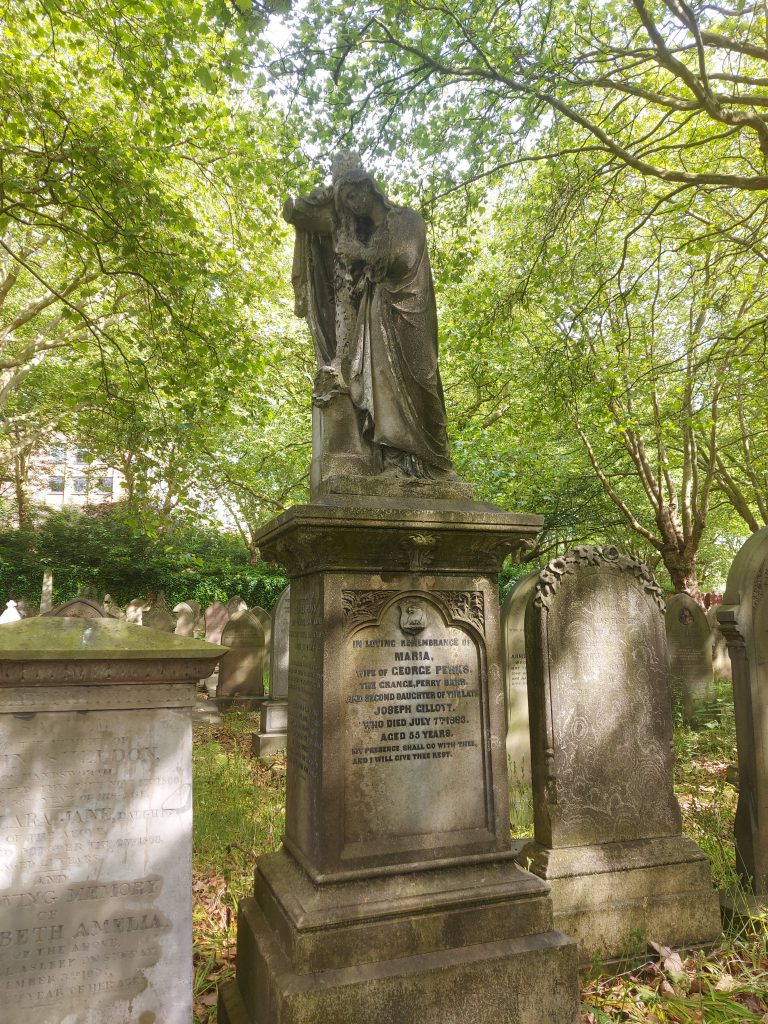
Perks family
Key Hill Cemetery, Section K, plot 328
Maria Perks was the daughter of pen manufacturer Joseph-GIllott, she is buried with her husband George Perks who bequeathed a sum of money for a memorial stained glass window and for the restoration of the West End of the South Aisle of Aston Church as a monument to his wife Maria and himself.
Faith: Usually depicted as a female figure with a cross.
Wood Family
Key Hill Cemetery, Section K, plot 118
William Henry Wood was a bookseller, who wrote a touching epitaph for his wife Jane when she “exchanged this life for immortality” saying: “I loved her much but now I love her more”.

Cherubs
Usually depicted as head and wings only, cherubs replace earlier winged skull designs (popular in the 17th and 18th centuries) as the focus of symbolism changed from death to resurrection.
Obelisks and Urns
There are many monuments in the cemeteries which harken back to older times for their inspiration; with both Roman and Greek inspiration often clearly visible. The Victorians tended to see themselves as the successors of Greek democracy and Roman civilisation and empire, so these styles appear widely in civic architecture and also gravestones, borrowing laurel victory wreaths and cremation urns for new use as symbols in cemeteries. The Victorians also tended to widely associate Ancient Egyptian symbols with death, so obelisks which to the Egyptians symbolised the sun god Ra, found new funerary meaning.
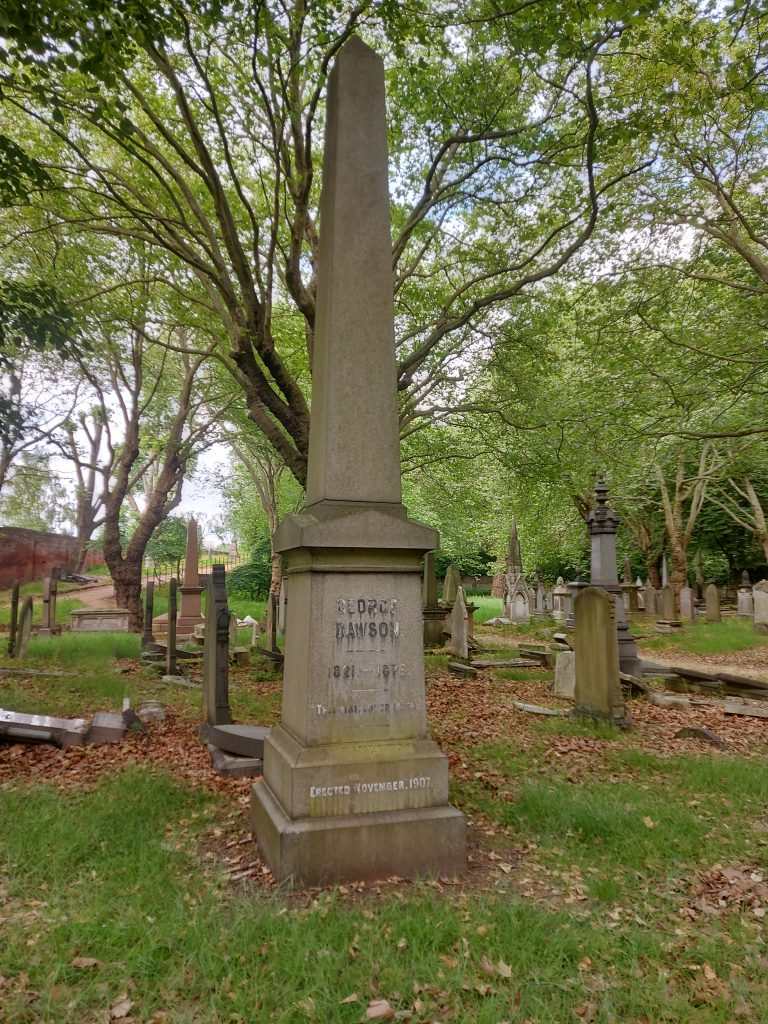
George Dawson
Key Hill Cemetery, Section O, plot 507
One of the largest obelisks in the Jewellery Quarter cemeteries was erected for a figure who looms large in the life of the city.
George Dawson was preacher, lecturer and activist, who argued for radical social and political reform. Dawson advocated for a ‘Civic Gospel’ which would improve life in towns like Birmingham. His passionate public lecturers and articles won his ideas many supporters, including Joseph Chamberlain and his contribution to Birmingham helped transform the city.
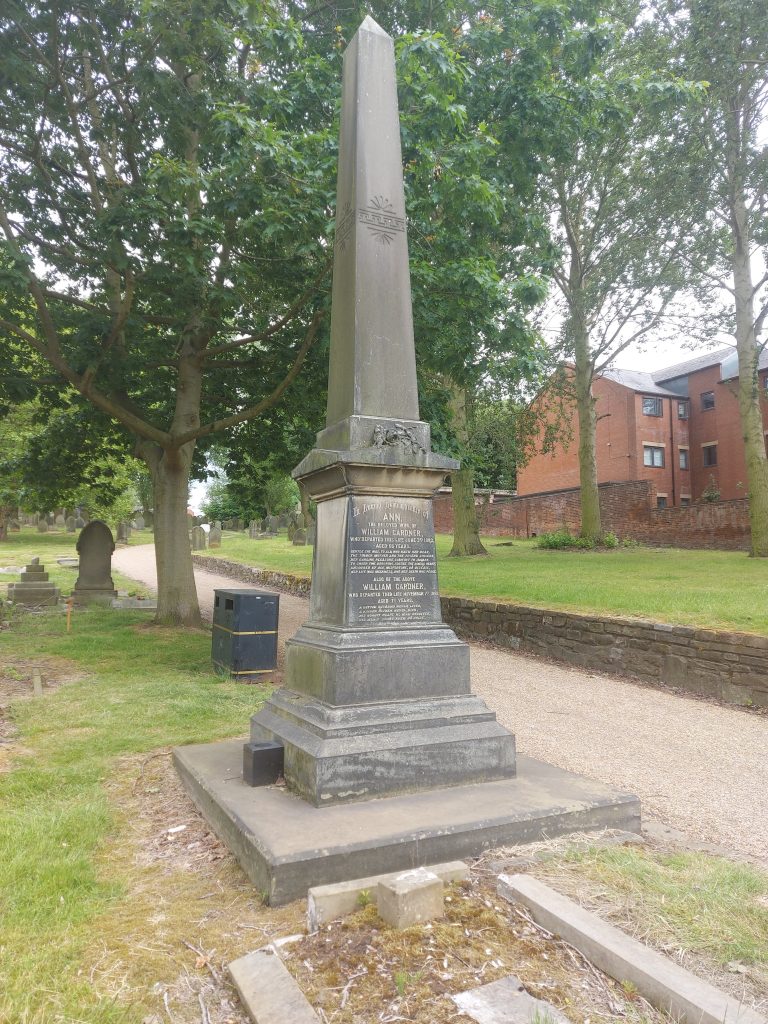
Gardner and Hobson families
Warstone Lane Cemetery, Section T, plot 1298
William Gardner was a publican, and ran the Vine public house on George Street with his wife Ann, daughter Emma and her husband James Hobson who was a brewer. The whole family lived together including their grandchildren.
This obelisk is highly decorated and includes roses and also designs on the obelisk itself which are more reminiscent of Greek than Egyptian architecture. These mixed architectural styles were common in the 19th century.
The memorial also features a poem about each family member. For William Gardner they wrote: “A better husband never lived, a kinder father never died, his honest heart no man deceived, his manly spirit knew no pride.”
Urns as a symbol for gravestones have their origin in Classical Antiquity when ashes were buried in urns shaped like these. This became a popular symbol for death although cremation was not an accepted method of disposal for Christians in the 19th century, with the practice not officially legalised in the United Kingdom until 1902.
Urns were often depicted with a fabric drapery partly or wholly covering them to represent the separation between life and death.
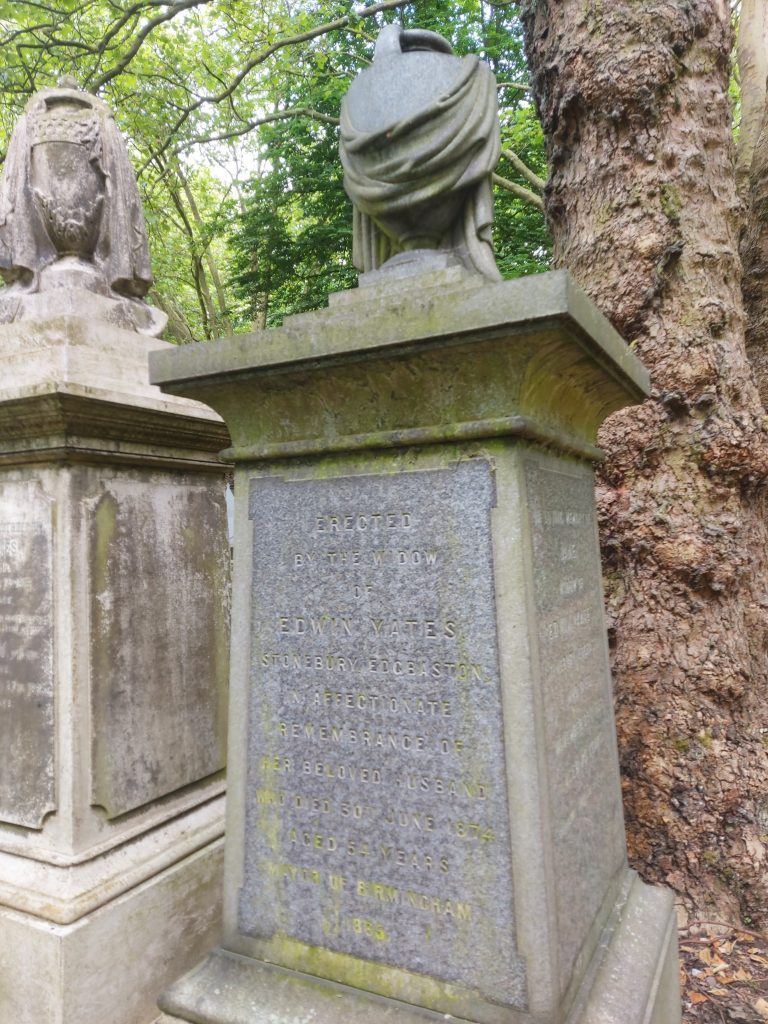
Edwin Yates
Key Hill Cemetery, Section K, plot 426
Yates was a councillor and mayor of Birmingham. He was a prominent Freemason, although no obvious masonic symbols appear on his memorial which was erected by his widow Jane.
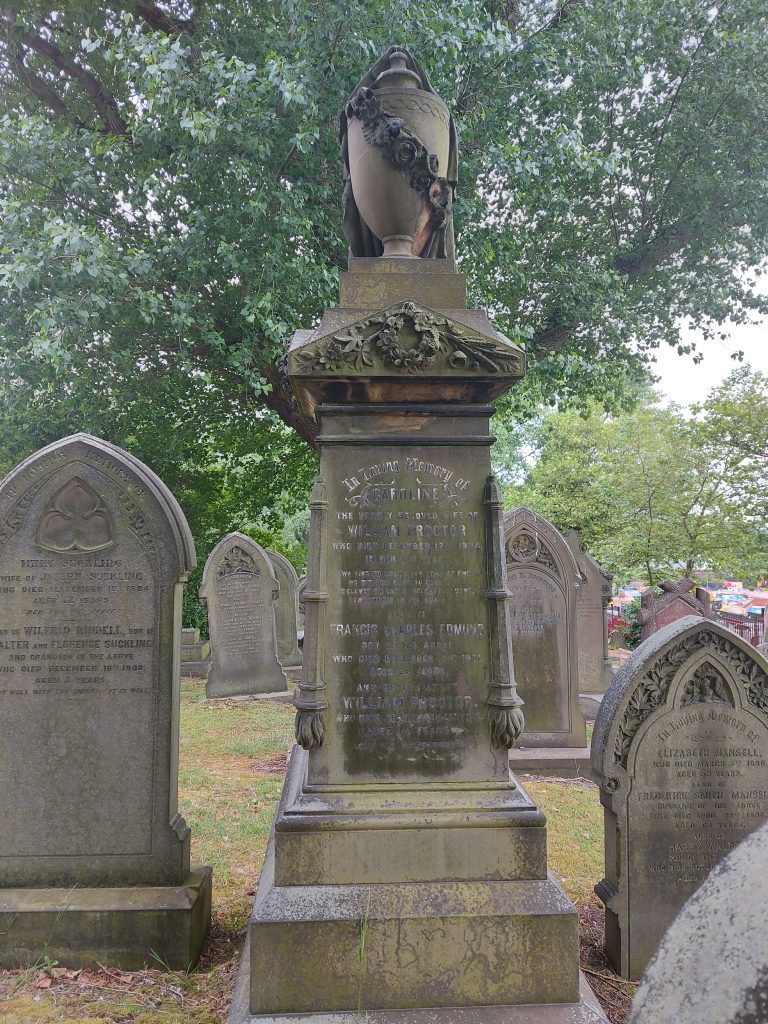
Proctor family
Warstone Lane Cemetery, Section I, plot 1792
“We live to mourn the loss of one we did our best to save, beloved on earth, regretted gone, remembered in the grave.”
This memorial is covered in symbolism including a draped urn, laurel wreath, roses, passionflowers, poppies and wheat.
Inverted torches: Also appear on the gates at Key Hill Cemetery, a symbol of eternal life because they cannot be extinguished.
Hands
Another common grave symbol are hands- pointing up, pointing down or clasping.
Hand pointing
A finger pointing up represents ascending to heaven, a finger pointing down represents God reaching down for the soul.
Clasped hands
This symbol represents the bonds of love and is often accompanied by sentiments about being reunited and meeting family again. Sometimes the cuffs show a man’s shirt and women’s blouse to represent a married couple.
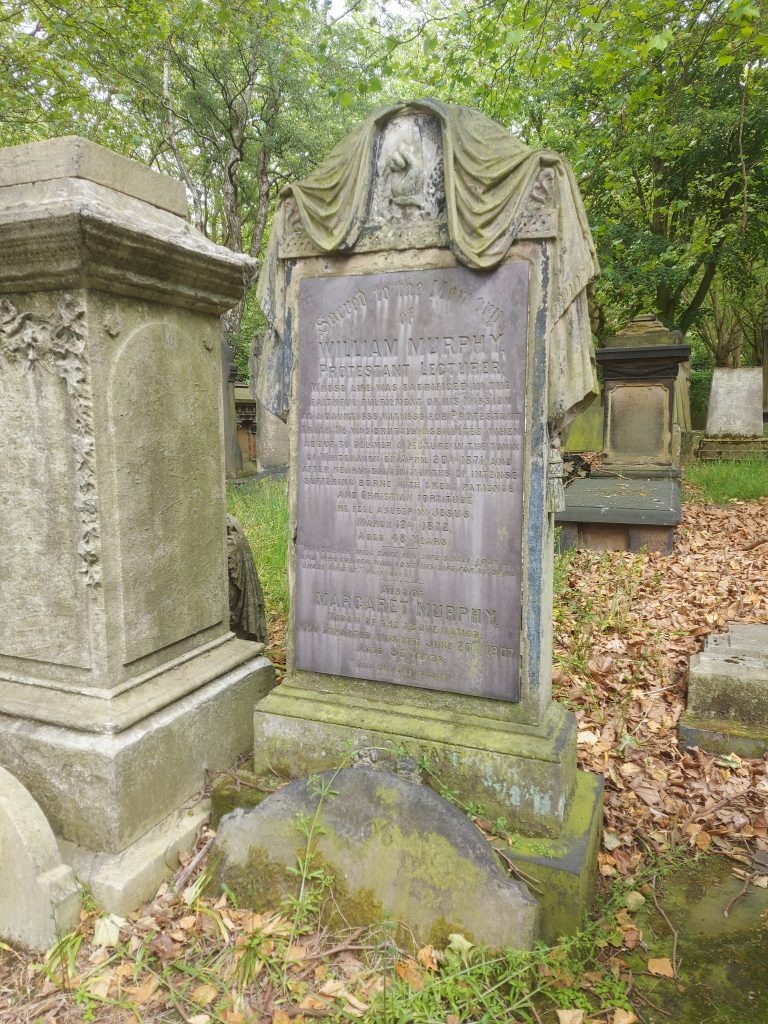
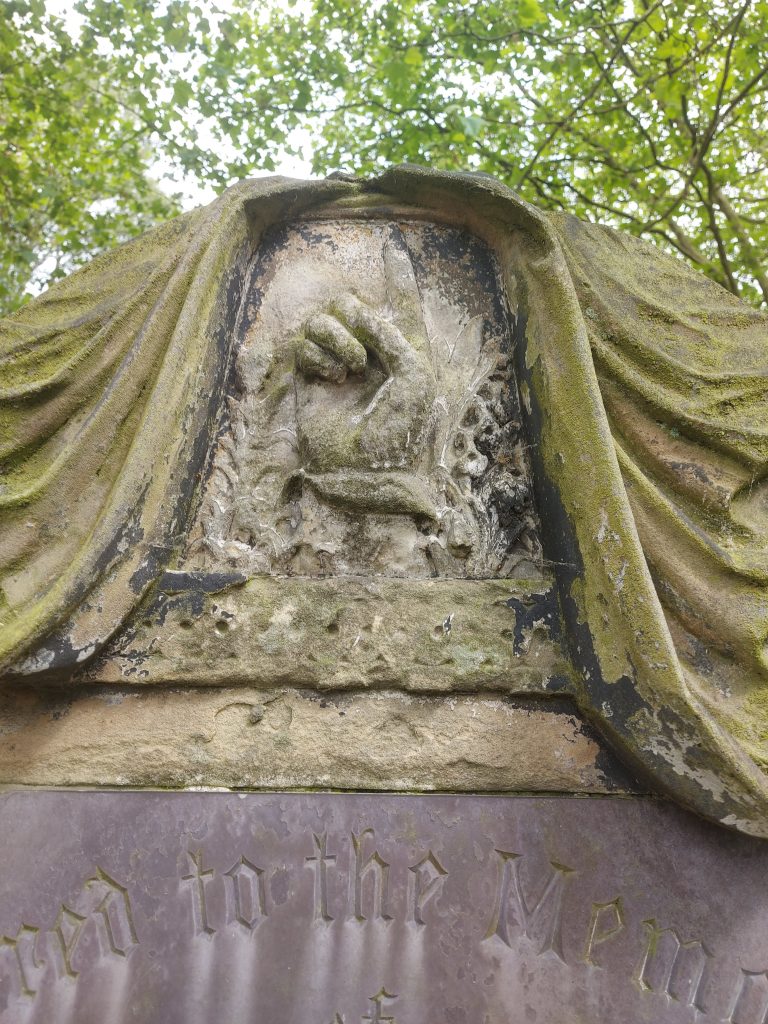
William Murphy
Key Hill Cemetery, Section I, plot 306
William Murphy was a protestant Lecturer and campaigner, born in Limerick, Ireland . He came to England to preach his anti-Catholic beliefs. Murphy travelled widely and attracted large audiences. He was a very divisive figure whose appearances led to the ‘Murphy Riots’ in many cities including in Birmingham. Murphy’s controversial views finally led to his death. He was assaulted while speaking in Whitehaven and injured, he never fully recovered and died 11 months later.
Smith family
Key Hill Cemetery, Section R, plot 307
Thomas Smith was a bricklayer who lived in Ivy Place with his wife Rebecca and children.
“In the midst of life we are in death.”
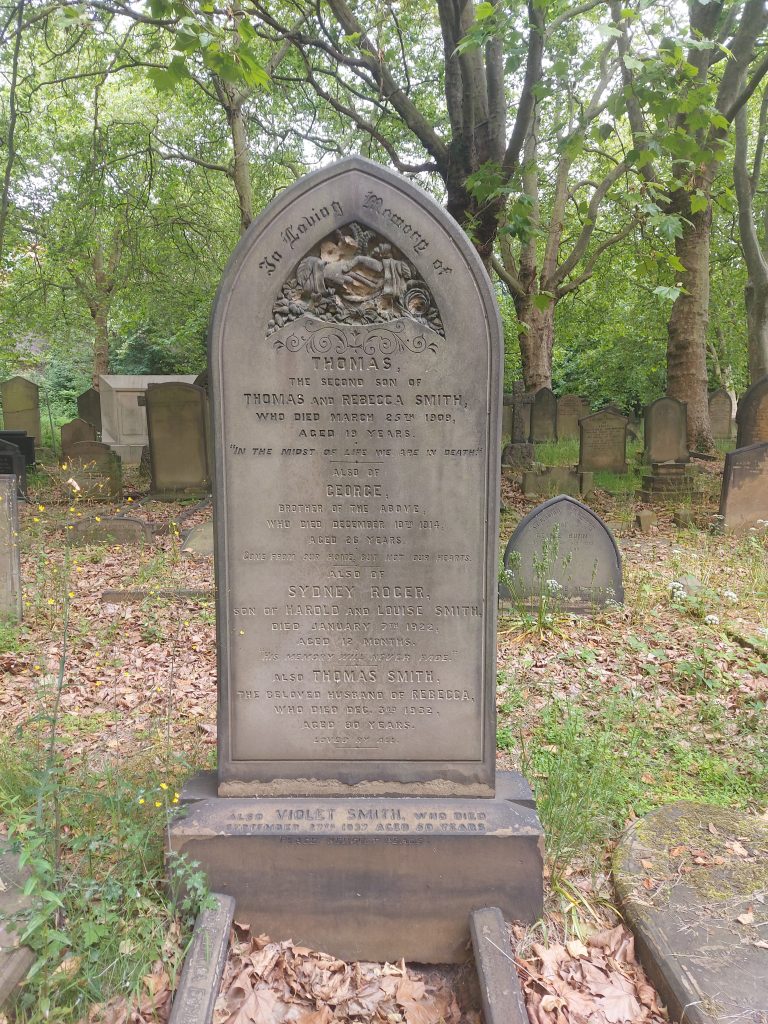
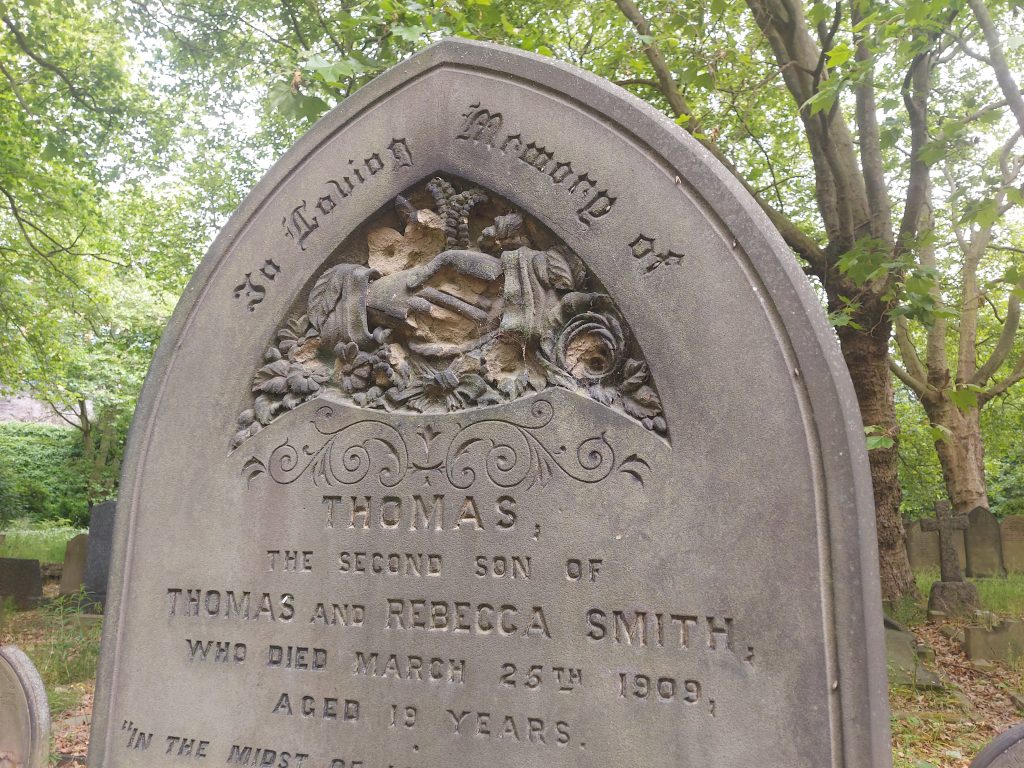
A Druid and a Gentleman
One of the most striking monuments in the Jewellery Quarter is made to resemble the triathlon stones at Stonehenge and was erected in memory of Brother George William Manley, ‘A gentleman and a druid’ by The Ancient Order of Druids.
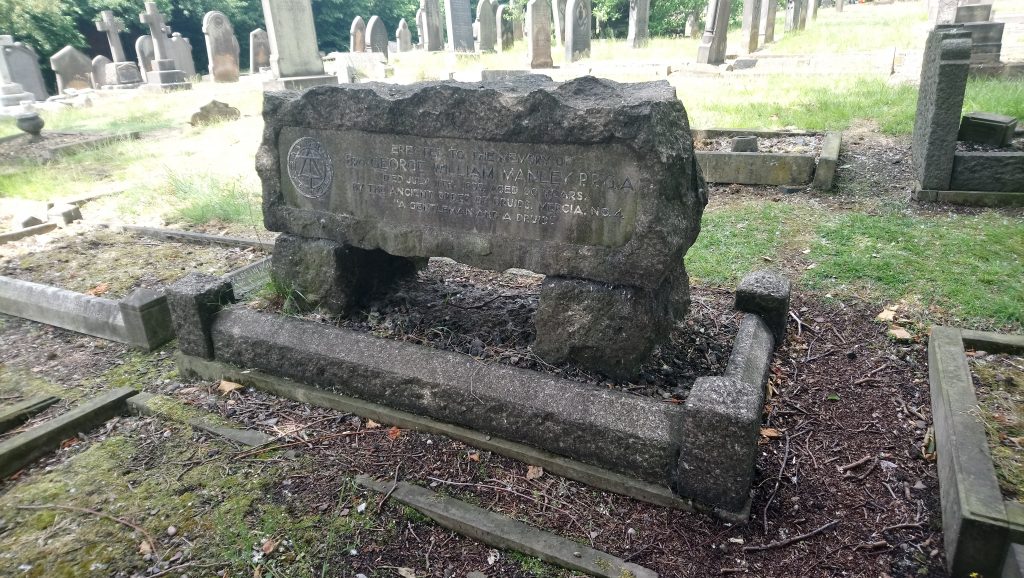
Brother George William Manley
Warstone Lane Cemetery, Section B, plot 1766
Formed in London in the late 18th century, the Ancient Order of Druids were a fraternal society, similar to the Freemasons. Despite using imagery associated with Britain’s pagan past, the society is non-religious and non-political. Their motto is ‘justice, philanthropy and brotherly love’. Therefore, the burial of a Druid in a Church of England cemetery is not unexpected.
